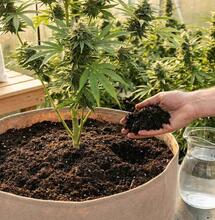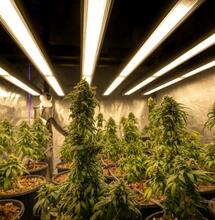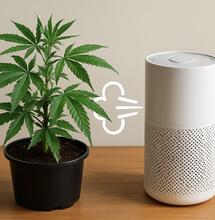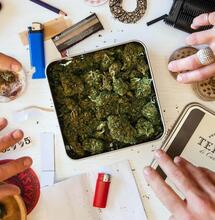A Beginner’s Guide for Breeding Cannabis Seeds

You have probably spent years buying and growing cannabis seeds, but did you ever think about making your cannabis seeds? Breeding cannabis plants to achieve a specific outcome is one of the most rewarding things a grower can do.
In this article, I break down what you should consider before making your cannabis seeds, the differences between regular and feminized, desirable traits and characteristics to focus on, harvesting and cleaning cannabis seeds, and common mistakes to avoid to help you plan your breeding project in advance.
The first step for breeding cannabis seeds - Making a plan in advance
Regardless of whether you are making regular cannabis seeds or feminized cannabis seeds in the comfort of your own home, the most critical factor is to have a goal set. Breeding cannabis plants is an art form that should be based on a desired outcome.
You may want to produce more of the genetic you are working with for preservation purposes, are working on a long-winded breeding project, or simply want to enhance a desirable trait or characteristics to improve the genetics in your eyes.
The differences between making regular and feminized cannabis seeds
If you have not made up your mind on which type of cannabis seeds to create, then knowing the main differences between regular sexed and feminized seeds will give you an advantage, and allow you to pursue the route that is more practical to your needs.
Regular sexed seeds are created by crossing a male and female plant together, and the seeds will produce male or female progeny. Feminized cannabis seeds are more difficult to make and will result in all of the seeds producing only female plants.
Feminized seeds are made using two female donor plants and colloidal silver or STS, so there is no need for a male in this case. Be sure the strength is at least 15ppm, preferably 30ppm. Less than 15ppm produces male sacs with little viable pollen as avised by R.Q.S.
Characteristics to consider when breeding cannabis
Below is a short list of plant characteristics that can be focused on and the reasons why. This will help you plan your breeding project, give you some ideas about why you are crossing cannabis plants together in the first place, and help you choose the right genetics.
Potency: The potency of a cannabis plant refers to how weak or strong the effect is when consumed. Cannabis plants produce cannabinoids, the most well-known being THC. How much THC a strain contains will typically refer to the potency level. One reason for breeding cannabis is to enhance the potency, resulting in a much higher THC reading when lab tested.
Yield: The yield refers to how many buds and flowers the plant will produce and will vary depending on the strain's genetics. For example, indica cannabis is known for making dense, round, golf ball-sized buds, while sativa plants produce an elongated acorn-shaped flower with an airy consistency. Cannabis Hybrids will express both sides of the spectrum and are often the most significant yielding cannabis seeds available. Enhancing the yield of a particular variety is one main incentive why a breeder would want to start crossing plants together.
Aroma: Cannabis plants will express themselves through their unique aroma produced by terpenes inside the trichomes and plant alcohols and esters. Haze varieties produce a floral, citrus, fruity, and tropical profile, whilst indicas lean on the earthy pungent spectrum. Kush plants have a dank, gas and fuel pungency, whilst the world-famous Zkittles has an unmistakable candy, floral aroma. Breeders can become inspired to start breeding by creating a new and exotic terpene profile.
Flavour: A high percentage of smokers out there put flavour at the top of their wish list when it comes to finding world-class cannabis. The way the strain tastes makes it enjoyable and unique, and everyone is different regarding what they want to taste.
Resin Production: When a cannabis plant is flowering, the amount of resin it produces on the buds and surrounding leaves is a telltale sign of the quality of the lineage, and plays a significant role in flavour, aroma, and usually potency.
Hash makers and extract artists will only want to work with the most resinous and cannabinoid rich strains on the market, and the more resin a plant contains, the more returns it will produce when talking about bubble hash, dry sift, BHO, or rosin. Enhancing the resin profile of a strain is often the primary goal of any breeder who intends to find a stunning plant that is photogenic and ticks all the boxes.
Flowering Time: The flowering time is how long a cannabis plant takes once flowering is induced. The number of weeks before the plant is ready to harvest can range from as short as 7 weeks to 12-13 weeks for old-school Sativa genetics.
For indoor cultivation, producing commercially viable strains ready for harvesting within 7-9 weeks makes sense. Zkittles, for example, can be chopped on day 50 for the ultimate flavour and effect, whilst OG Kush or Sour Diesel crosses require 65-70 days before they are ready. A reduction in flowering time can often be a good reason to start breeding cannabis plants and reduce the number of weeks to give a strain a quicker turnaround time.
Resilience: Have you ever worked with a plant that had a serious problem with mold once it started flowering, or did not perform well under cold climates or a heat wave? You may have found a strain that could not take a lot of nutrients or always performed poorly in certain climates towards the end of the outdoor growing season, and was prone to a bad case of powdery mildew. Breeding these traits out of a plant to help it perform better is one reason to start breeding at home, to create a much more resilient and resistant variety.
Common cannabis breeding mistakes and how to avoid them
Once you have worked on the reason why you want to make your cannabis seeds at home, and know what your intention and end goal are, avoiding common mistakes will help you become well-versed as a breeder. Below are the most common mistakes to avoid and what to consider.
Harvesting the seeds too early
Once a female cannabis plant has been pollinated, it will take 5-6 weeks for the plant to focus all of its energy on making brown, mature seeds. You should only harvest cannabis seeds from a plant when they are hard to squeeze and appear as if they are bursting out of the buds. Avoid harvesting pale or white seeds, as these will not be viable and will typically not germinate.
Not cleaning the seeds up once harvested.
When you notice that the seeds are fully mature and ripe, the time will come to harvest them off the plant, dry them out, and carefully clean away any surrounding plant material. Seeds with plant material will begin to mould if not cleaned up properly before being placed inside a bag, which will spread to the other seeds.
A good way to clean cannabis seeds is to rub them together until no plant matter is left and let them dry. I always found that cleaning seeds in a bowl with uncooked rice works a treat and also speeds up the dying process.









